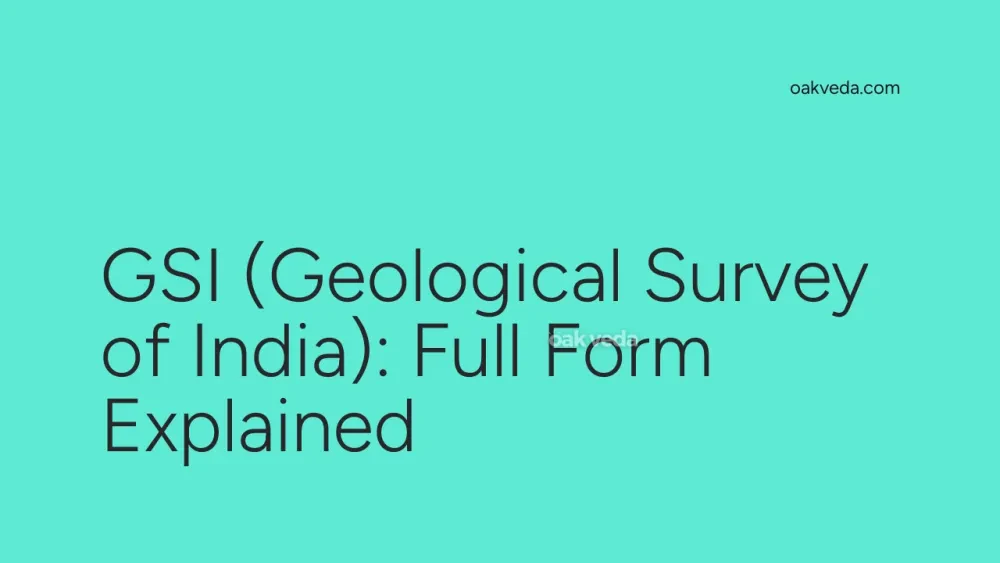
What is the Full Form of GSI?
The full form of GSI is Geological Survey of India. This prestigious organization plays a crucial role in India's geological research, mineral exploration, and earth science studies.
What is Geological Survey of India?
The Geological Survey of India (GSI) is a premier government agency in India dedicated to conducting geological surveys and studies across the country. As the nation's second-oldest survey organization, GSI operates under the Ministry of Mines and has been instrumental in shaping India's geological understanding and mineral resource management.
Origin and Development of Geological Survey of India
Founded in 1851, the Geological Survey of India has a rich history spanning over 170 years. The organization was established during the British colonial era to explore and assess India's mineral wealth. Since its inception, GSI has evolved into a multifaceted institution that addresses various aspects of earth sciences.
The headquarters of GSI is located in Kolkata, West Bengal. To ensure comprehensive coverage of India's diverse geological landscape, the organization has established six regional offices in key locations: Jaipur, Lucknow, Nagpur, Hyderabad, Kolkata, and Shillong.
How does Geological Survey of India work?
GSI operates through a structured approach, focusing on five primary missions:
- Mineral Resource Assessments: Evaluating and mapping India's mineral deposits.
- Baseline Surveys: Conducting comprehensive geological studies across the country.
- Geoinformatics: Utilizing advanced technology for data management and analysis.
- Training and Capacity Building: Developing skilled professionals in earth sciences.
- Multi-disciplinary Geosciences: Addressing various aspects of geological research.
To enhance its effectiveness, the Union Cabinet established a High Powered Committee (HPC) to evaluate GSI's work and assess its capabilities in meeting emerging challenges. This committee considers both technical and human resources to ensure the organization remains at the forefront of geological research.
Functions of Geological Survey of India
The Geological Survey of India performs several critical functions:
-
Data Provision: GSI provides essential earth science data to industries, government bodies, and the general public.
-
International Collaboration: The organization actively participates in international geoscientific forums, fostering global cooperation in earth sciences.
-
National Geoscientific Database: GSI creates and maintains the National Geoscientific Data and Mineral Resource Assessment, including airborne and marine surveys.
-
Specialized Studies: The agency conducts various geo-technical, geo-environmental, and natural hazard studies, including glaciology research.
-
Geological Mapping: One of GSI's primary responsibilities is to create and update the geological map of India, which is crucial for mineral exploration, including coal.
Applications of Geological Survey of India
The work of GSI has wide-ranging applications across various sectors:
-
Mineral Exploration: GSI's surveys and assessments guide the mining industry in locating and extracting valuable mineral resources.
-
Urban Planning: Geological data helps in sustainable urban development and infrastructure planning.
-
Disaster Management: GSI's studies on natural hazards contribute to better disaster preparedness and mitigation strategies.
-
Environmental Conservation: The organization's research aids in understanding and preserving India's diverse ecosystems.
-
Energy Sector: GSI's work supports the exploration of fossil fuels and the development of renewable energy sources.
Features of Geological Survey of India
-
Comprehensive Coverage: GSI conducts surveys and studies across India's varied geological terrains.
-
Advanced Technology: The organization employs cutting-edge technology for accurate data collection and analysis.
-
Multidisciplinary Approach: GSI integrates various earth science disciplines for holistic research.
-
Historical Expertise: With over 170 years of experience, GSI has unparalleled knowledge of India's geology.
-
Public Service: GSI makes its data and findings accessible to both government and public sectors.
Benefits of Geological Survey of India
-
Economic Growth: GSI's work supports India's mining and mineral-based industries, contributing to economic development.
-
Scientific Advancement: The organization's research enhances India's understanding of earth sciences.
-
Resource Management: GSI's assessments help in the sustainable management of mineral resources.
-
Disaster Preparedness: Studies on natural hazards improve the nation's ability to predict and mitigate geological disasters.
-
Environmental Protection: GSI's research contributes to the conservation of India's natural landscapes and ecosystems.
Limitations or Challenges of Geological Survey of India
-
Resource Constraints: Like many government organizations, GSI faces challenges in terms of funding and human resources.
-
Technological Gaps: Keeping pace with rapidly evolving geological research technologies can be challenging.
-
Data Accessibility: Improving the accessibility of geological data to all stakeholders remains an ongoing challenge.
-
Environmental Concerns: Balancing mineral exploration with environmental conservation is a complex task.
-
Coordination: Effective coordination with various state and central government agencies can be challenging.
Future Developments in Geological Survey of India
As India continues to grow and evolve, so does the role of GSI. Future developments may include:
-
Advanced Remote Sensing: Incorporating more sophisticated satellite and drone technologies for geological mapping.
-
Artificial Intelligence: Implementing AI and machine learning for data analysis and prediction models.
-
Climate Change Studies: Expanding research on the geological aspects of climate change and its impacts.
-
Deep-Sea Exploration: Enhancing capabilities for studying India's vast marine geological resources.
-
Public Engagement: Developing more initiatives to increase public awareness and participation in geological sciences.
FAQs on GSI Full Form
-
What does GSI stand for in geology? GSI stands for Geological Survey of India in the context of geology.
-
When was the Geological Survey of India established? The Geological Survey of India was established in 1851.
-
Where is the headquarters of GSI located? The headquarters of GSI is located in Kolkata, West Bengal.
-
How many regional offices does GSI have? GSI has six regional offices located in Jaipur, Lucknow, Nagpur, Hyderabad, Kolkata, and Shillong.
-
What are the main functions of the Geological Survey of India? The main functions of GSI include conducting geological surveys, mineral resource assessments, creating geological maps, and providing earth science data to various stakeholders.
You may be interested in:

